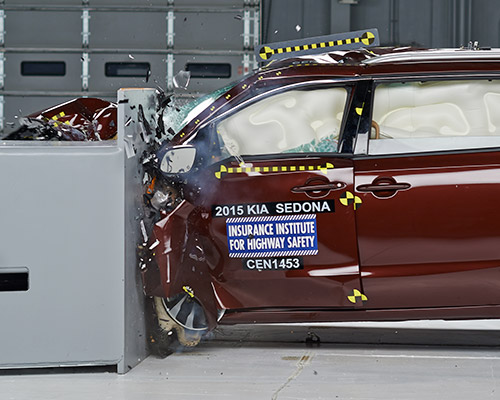Since then, automakers have steadily increased the number of good or acceptable small overlap ratings by factoring in the test when they redesign a vehicle or introduce a new model and by making modifications to the structure and airbags between redesigns.
The Honda CR-V, a 2015 TOP SAFETY PICK+ winner, is an example of a vehicle that was successfully modified for improved protection. Previously, the small SUV earned a marginal rating when it was tested in 2012. The structure didn't hold up, with intrusion into the driver space exceeding 1 foot. The dummy's head barely contacted the front airbag before sliding off as the steering column moved to the right.
Honda made changes to the vehicle's front-end structure, occupant compartment and restraint system for the 2015 model year. In the most recent test, maximum intrusion was 5 inches at the parking brake pedal, and the dummy's head remained on the front airbag until rebound. Today's CR-V earns a good rating.
The Toyota Prius v, which also earns TOP SAFETY PICK+, saw even greater improvement. The midsize car had been one of the worst performers ever in the small overlap test. In 2012, the structure collapsed, and the dummy's head hit the instrument panel and ended up between the side curtain airbag and the door. Measures from the dummy showed left hip and lower leg injuries were very likely.
After the structure was improved and the side curtain airbag was lengthened, the 2015 Prius v performed well all-around, with low levels of intrusion, good restraint performance and low injury measures.
Manufacturers are employing some common strategies when it comes to beefing up structure for small overlap protection. In the CR-V's case, the door frame was strengthened, and the side frame under the fender was reinforced. The beefed-up side frame ties into the main frame rail, producing an additional load path for energy absorption. On the Prius v, the front bumper was extended and the door frame strengthened. In addition, structure was added to better tie the door-hinge pillar to the frame rail.
Front crash prevention spreads
The list of 2015 TOP SAFETY PICK+ winners shows how quickly front crash prevention systems with autobrake are spreading. In total, there are 27 superior-rated 2015 models and 33 with an advanced rating. (Some of those vehicles don't qualify for TOP SAFETY PICK+ because they don't meet all the crashworthiness criteria.)
Most of the TOP SAFETY PICK+ winners earn the award only when equipped with optional front crash prevention systems. However, when not equipped, they still meet the crashworthiness criteria for TOP SAFETY PICK.
Currently only three automakers offer standard front crash prevention systems. Volvo models have standard City Safety, a low-speed autobrake system. The Mercedes-Benz C-Class and E-Class have a warning and autobrake system, but the standard autobrake components haven't been tested yet. The Mercedes-Benz M-Class and CLA and the Acura RLX offer standard warning systems. All these vehicles are available with optional systems that earn higher ratings than the standard equipment. The CLA, which earns an advanced rating with its optional system, hasn't been tested for crashworthiness.
Kia Sedona is 2nd minivan to rate good in small overlap test
When the Institute released small overlap results for minivans in November, the results were disappointing, with three models performing poorly (see "Minivans with a major flaw: 3 models have dire small overlap results," Nov. 20, 2014). At that time, the Honda Odyssey was the only minivan to earn a good rating in the test. Now the 2015 Kia Sedona joins the Odyssey at the top of the list.

The 2015 Sedona was tested twice, and the good rating is based on the second test. In the first test, the vehicle didn't perform well because the driver door opened. Doors should remain closed in a crash because an open door increases the risk of ejection. In the Sedona's case, the door also performs an important structural function, so the level of crush ended up being much worse than it would have been had the door remained closed.
The doors of most late-model vehicles automatically lock when the vehicle is in gear or reaches a certain speed. In some cases, the feature can be disabled by the consumer. For those vehicles, the Institute's policy is to unlock the doors for the test.
After the Sedona's first test, Kia told IIHS that the door-locking function would be changed so that consumers could no longer turn it off. Sedonas built after November have the new setting, and the company is planning a service campaign to change this on earlier 2015 Sedonas.
In light of the change, IIHS conducted the second test with the doors locked. This time all doors remained closed, resulting in the good rating.
The new Sedona is a TOP SAFETY PICK winner, with good ratings in all the other crashworthiness tests, including roof strength. The previous generation had poor roof strength. The Sedona's optional front crash prevention system earns a basic rating.
2015 TOP SAFETY PICK and TOP SAFETY PICK+ winners
Vehicles can qualify for one of the awards with either a good or acceptable rating in the small overlap front crash test, along with good ratings in the other four crashworthiness evaluations. In addition, TOP SAFETY PICK+ winners must have an advanced or superior rating for front crash prevention. The front crash prevention ratings below reflect the highest-rated systems available. In all cases, these are optional systems. A few models have standard systems with lower ratings. Details on standard systems can be found by searching for the specific vehicle in the ratings section.
More Articles
- Julia Sneden: Niggly Things
- Elaine Soloway's Rookie Widow Series: Cheapskate, Environmentalist, or Chicken; Que Sera, Sera; Ink Fades, Memories Linger
- Automatic Emergency Braking Systems Available From 10 Car Companies ... And Not Just Luxury Brands
- Get a Grip on That Steering Wheel: You're Getting Older But Still Like the Wind in Your Hair






